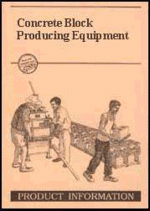Jesson Lightning static brick/paver/block machine[edit | edit source]
Description[edit | edit source]
The Lightning Static Machine is an all-steel stationary unit capable of making a variety of concrete bricks, pavers and blorks at a high output rate. Several interchangeable moulds are available and special moulds can be made to order.
The main features are:
- 800 to 1000 drops per 8 hour day, producing up to 12000 bricks, 10000 pavers or 3000 blocks per day.
- No concrete slab needed - product made on pallets (pallet size 60 x 51 cm; recommended board thickness 19 or 21 mm).
- 220 or 380 volt electric vibration - high frequency.
- Fully protective electrical overload system.
- No bronze bushing - vasconite used throughout.
- On-site maintenance avoids any costly "down" time.
- Hydraulic ram operated compactor available on specific request for ultra density needs.
Operating the Lightning Static Machine[edit | edit source]
A fully instructed, skilled operator and a constant supply of concrete are prerequisites for high production rates with the Lightning Static. But in general the machine is simple to operate.
The mould is lowered onto the wooden pallet and the compactor raised, so that concrete can be filled into the mould. The vibrator is switched on for half a second and the excess concrete is screeded off the mould. The compactor is then lowered onto the concrete and the vibrator set in motion until the locked nuts on two threaded rods rest on the housing' preventing further compaction.
The mould release handle is pulled down and secured in the lowered position by a sliding bolt, so that the product is released from the machine. A new pallet is inserted and pushed onto the vibration table, as a result of which the loaded pallet is pushed out of the machine. The freshly moulded products are carried away on their pallet to the curing place, while the mould is lowered onto the new pallet and the process repeated.
In case of a power cut due to electric overload, the red button should be pressed after 5 minutes
to reset the machine. If the overload does not reset, an electrician should be called.
The principle maintenance requirements are:
- thorough cleaning of the machine and moulds after daily use, because concrete deposits corrode;
- lubricating all moving parts with thin, clean oil - never grease;
- replacing vasconite bushes when worn, in order to protect the steel shafts
- protecting electrical components from getting wet;
- dipping pallets in used motor oil every 4 months to prolong their service life.
|
Technical Details |
Lightning Static Machine | |
|
Size of machine (length x width x height) |
150 x 110 x 210 cm (59 x 43 x 83 in) | |
|
Weight of machine (without mould) |
550 kg | |
|
(with mould) |
700 kg | |
|
Size of crate for shipment (palleted) |
1 |
100 x 80 x 160 cm (39 x 31 x 63 in) |
|
2 |
100 x 80 x 90cm(39x31x35in) | |
|
Weight of packed machin |
1 + 2 |
750 kg |
|
Standard brick sizes (I x w x h) |
a. |
22 x 10.5 x 7.5 cm (8.7 x 4.1 x 3 in) |
|
b |
19x9x9cm (7.5x3.5x3.5 in) | |
|
Standard block sizes |
c |
44 x 22 x 22 cm (17.3 x 8.7 x 8.7 in) |
|
d |
44xl5x22cm(17.3x5.9x8.7in) | |
|
e |
44x 10.4x22cm(17.3x4.1x8.7 in) | |
|
Bevelled pavers (rect./interlocking) |
f. |
20 x 10 cm (7.9 x 3.9 in) x any thickness |
|
Energy input |
electrical (220 or 380 V) | |
|
No. of bricks per cycle/output rate (a, b) |
12/1500 bricks per hour | |
|
No. of blocks per cycle / output rate (c, d, e) |
2 - 4 / 350 blocks per hour | |
|
No. of pavers per cycle / output rate (f) |
10 rect. or 8 interlocking / 1200 pavers per hour | |
|
Labour force required |
8 men | |
|
(1 operating machine, 4 removing loaded/resuming empty pallets, 3 loading/operating mixer) | ||
|
Price (ex works) |
Lightning Static (incl mould/compactor) | |
|
valid June 1991 |
with hydraulic compaction |
15750 R (» 5950 US0 |
|
R = South African Rand |
without hydraulic compaction |
11000 R (» 4000 US0 |
